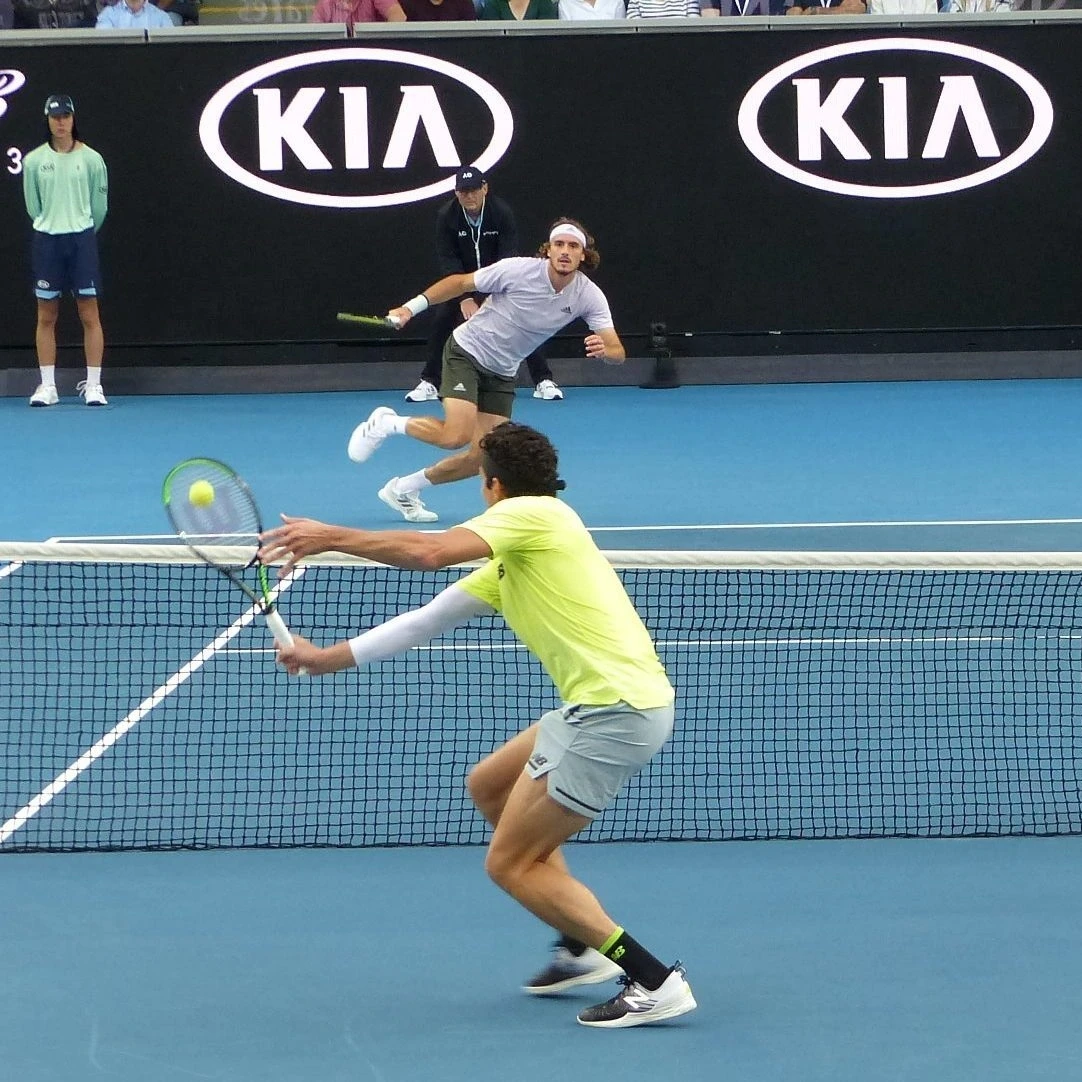Well not exactly...but that was how Stefanos Tsitsipas described the barrage of big serves and raking forehands that propelled Milos Raonic to a 7-5, 6-4, 7-6(2) victory over him in the third round of the Australian Open on Friday.
“You’re just there getting punched in the face with one shot,” said the sixth-seeded Tsitsipas after the match. “You can’t do much, which in that case is the serve, serving aces ‘T,’ wide, on the line – so precise, so accurate, which is obviously a skill.”
Raonic made 65 per cent of his first serves, won 89 per cent of his first-serve points and 59 per cent of his second-serve points. Tsitsipas wasn’t that far off with 66 per cent of first serves made, 74 per cent of first-serve points won and 50 per cent of second-serve points won.
 The margins weren’t that great but Raonic always seemed to have the upper hand. There were only two service breaks in the match and they came at opportune times for Raonic – one in the penultimate game of the first set and one in the opening game of the second set, setting the tone and allowing him to continue to on build his momentum.
But there was more than the serve for Raonic, who was hyper-aggressive on the night in Margaret Court Arena, never giving Tsitsipas a chance to get comfortable with his game. “He’s playing forehands from all over the court and you really don’t know where you should stand exactly because he’s so fast turning around and hitting those forehands,” Tsitsipas said.
The forehand was dynamite but Raonic was also almost impeccable volleying and hitting his overheads. He had 55 winners compared to 23 for Tsitsipas and was timely with his incursions to the net – winning 29 of 41 net points.
“I knew for me today it was going to be important that I play well,” Raonic said, “and I played consistently well throughout the match. I wasn’t having any fluctuations. I think that was how I was going to create my opportunities, and it worked out well.”
He had six chances to break serve and broke twice – Tsitsipas had no chances and said the last time he played a best-of-five set match and didn’t have a break point was in 2017 against John Isner at Wimbledon.
The all-round mastery Raonic displayed on the night was never more evident than in the decisive third-set tiebreak. Leading 2-1, he moved forward and put away a backhand volley to get the mini-break, and a lead he would not relinquish – stretching it to 6-1 and eventually closing out 7-2.
The margins weren’t that great but Raonic always seemed to have the upper hand. There were only two service breaks in the match and they came at opportune times for Raonic – one in the penultimate game of the first set and one in the opening game of the second set, setting the tone and allowing him to continue to on build his momentum.
But there was more than the serve for Raonic, who was hyper-aggressive on the night in Margaret Court Arena, never giving Tsitsipas a chance to get comfortable with his game. “He’s playing forehands from all over the court and you really don’t know where you should stand exactly because he’s so fast turning around and hitting those forehands,” Tsitsipas said.
The forehand was dynamite but Raonic was also almost impeccable volleying and hitting his overheads. He had 55 winners compared to 23 for Tsitsipas and was timely with his incursions to the net – winning 29 of 41 net points.
“I knew for me today it was going to be important that I play well,” Raonic said, “and I played consistently well throughout the match. I wasn’t having any fluctuations. I think that was how I was going to create my opportunities, and it worked out well.”
He had six chances to break serve and broke twice – Tsitsipas had no chances and said the last time he played a best-of-five set match and didn’t have a break point was in 2017 against John Isner at Wimbledon.
The all-round mastery Raonic displayed on the night was never more evident than in the decisive third-set tiebreak. Leading 2-1, he moved forward and put away a backhand volley to get the mini-break, and a lead he would not relinquish – stretching it to 6-1 and eventually closing out 7-2.
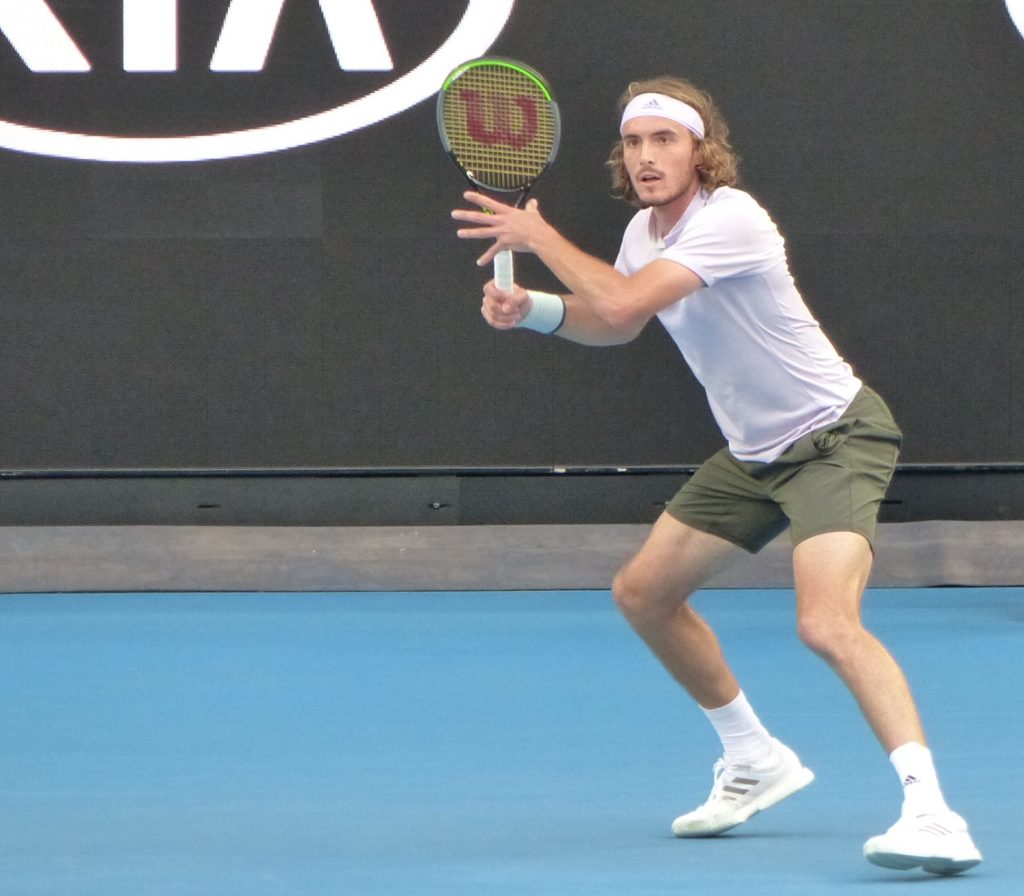 Tsitsipas was remarkably candid after the match, saying about facing such an exceptional server, “you have such a great server like (6-foot-5) him and you’re trying to, because you’re tall (6-foot-4) as well, you’re trying to do the same as him. Then you cannot be like him – he’s him, you’re you.”
Tsitsipas, being “you’re you,” had nine aces to 19 for Raonic.
The 21-year-old Greek seemed edgy the first two sets trying to find an answer for Raonic’s powerful serving and aggressive ground game. But in the third he knuckled down and played nearer his best level but still Raonic was just that little bit better.
“In the tiebreak, he was very, very aggressive,” Tsitsipas said. “I was passive, I wasn’t pressing. Yeah, he was doing a lot of damage with his forehand.”
Tsitsipas was remarkably candid after the match, saying about facing such an exceptional server, “you have such a great server like (6-foot-5) him and you’re trying to, because you’re tall (6-foot-4) as well, you’re trying to do the same as him. Then you cannot be like him – he’s him, you’re you.”
Tsitsipas, being “you’re you,” had nine aces to 19 for Raonic.
The 21-year-old Greek seemed edgy the first two sets trying to find an answer for Raonic’s powerful serving and aggressive ground game. But in the third he knuckled down and played nearer his best level but still Raonic was just that little bit better.
“In the tiebreak, he was very, very aggressive,” Tsitsipas said. “I was passive, I wasn’t pressing. Yeah, he was doing a lot of damage with his forehand.”
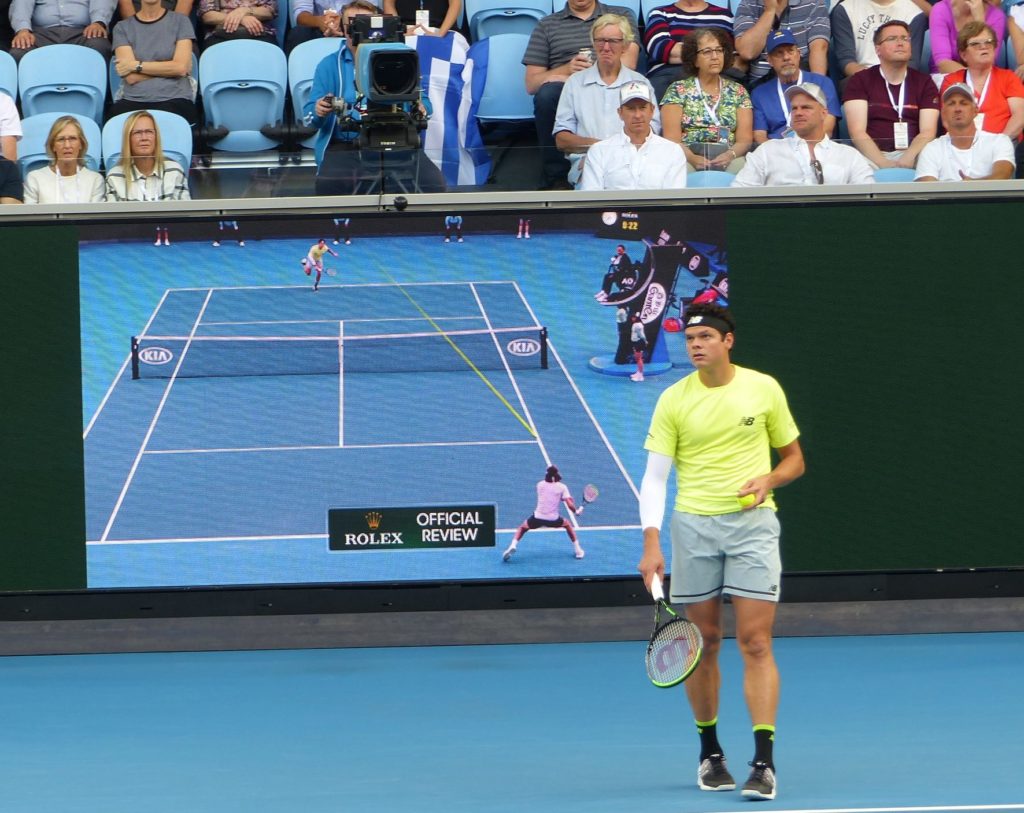 Really the only time Tsitsipas appeared to be getting a handle on the Raonic serve was when he saved three set points from love-40 in the final game of the second set. He saved a fourth too but not a fifth as Raonic tied a bow on the set with a 189 km/hr ace followed by a 212 km/hr service winner.
The 7,500-seat Margaret Court Arena is a sweet place to play a match, especially on a pleasant, temperate summer night and Raonic expressed his appreciation to the crowd in the post-match, on-court interview. “Obviously today was an incredible match for me and I’m very happy with how things went,” he said. “To be back here in Margaret Court – it’s been a while and I always enjoy it here. It’s fun to be healthy and to be playing well. I really take a lot of pleasure in that.”
Raonic attributes his fine form to time he spent in November and December rehabbing a troublesome back that plagued most of last year. “I switched around the people that are with me,” he said, “so the methods have been a little bit different in that sense. So tennis coaches (Mario Tudor, a 41-year-old Croat) stayed the same. Everybody else sort of rotated around what I was doing in the gym, how I was rehabbing and these kinds of things. I spent two weeks in Boston to help focus on a few things there with a group of guys, and then I spent four weeks training down in the Caribbean (the Bahamas).”
With his three wins at the 2020 Australian Open, the event has officially become his most successful Grand Slam tournament. His match record is 30-9 at Melbourne Park and Wimbledon is now No. 2 at 27-9.
“I’m just mentally fresh because I haven’t carried a lot of things with me like I might through other parts of the year,” Raonic explained about his good results at the AO, including a semi-final in 2016, ‘like the US Open where I think I should have done better, considering how those courts play. I think it’s more my situation that I bring into the tournament than anything else.
“And I think here it tends to be warmer, speeds it up a little bit. It can be humid but most of the time it’s not too humid, so that also allows the ball to move quicker through the court.”
Really the only time Tsitsipas appeared to be getting a handle on the Raonic serve was when he saved three set points from love-40 in the final game of the second set. He saved a fourth too but not a fifth as Raonic tied a bow on the set with a 189 km/hr ace followed by a 212 km/hr service winner.
The 7,500-seat Margaret Court Arena is a sweet place to play a match, especially on a pleasant, temperate summer night and Raonic expressed his appreciation to the crowd in the post-match, on-court interview. “Obviously today was an incredible match for me and I’m very happy with how things went,” he said. “To be back here in Margaret Court – it’s been a while and I always enjoy it here. It’s fun to be healthy and to be playing well. I really take a lot of pleasure in that.”
Raonic attributes his fine form to time he spent in November and December rehabbing a troublesome back that plagued most of last year. “I switched around the people that are with me,” he said, “so the methods have been a little bit different in that sense. So tennis coaches (Mario Tudor, a 41-year-old Croat) stayed the same. Everybody else sort of rotated around what I was doing in the gym, how I was rehabbing and these kinds of things. I spent two weeks in Boston to help focus on a few things there with a group of guys, and then I spent four weeks training down in the Caribbean (the Bahamas).”
With his three wins at the 2020 Australian Open, the event has officially become his most successful Grand Slam tournament. His match record is 30-9 at Melbourne Park and Wimbledon is now No. 2 at 27-9.
“I’m just mentally fresh because I haven’t carried a lot of things with me like I might through other parts of the year,” Raonic explained about his good results at the AO, including a semi-final in 2016, ‘like the US Open where I think I should have done better, considering how those courts play. I think it’s more my situation that I bring into the tournament than anything else.
“And I think here it tends to be warmer, speeds it up a little bit. It can be humid but most of the time it’s not too humid, so that also allows the ball to move quicker through the court.”
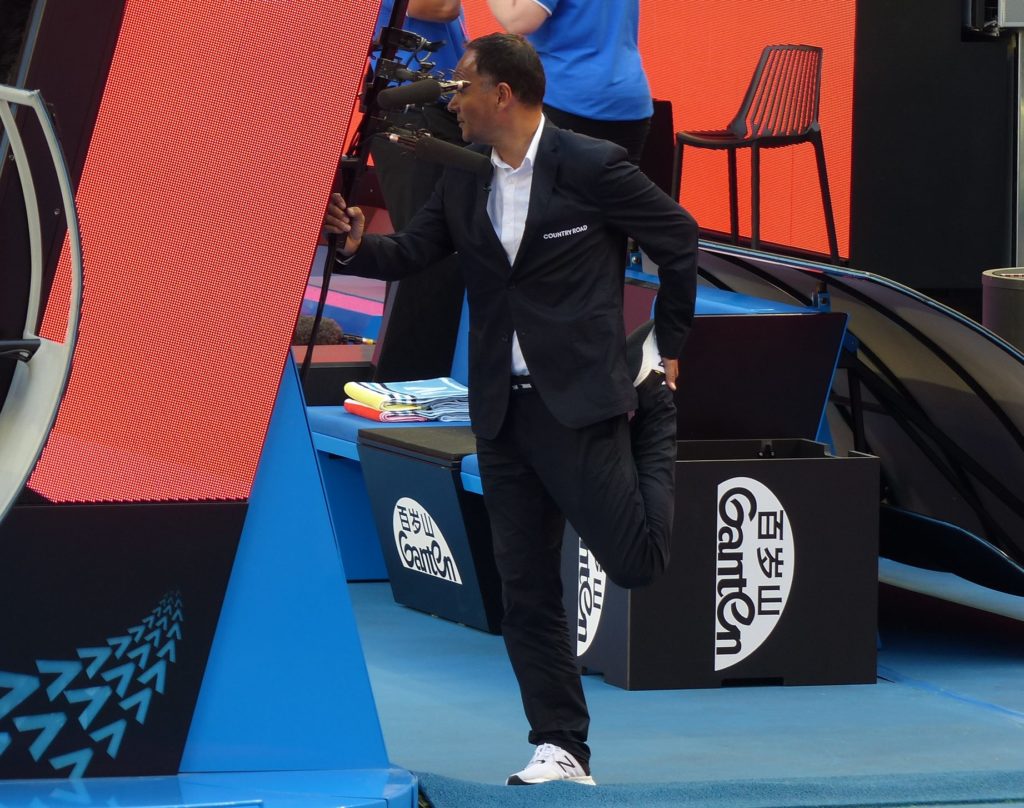 Before the Raonic – Tsitsipas contest, veteran umpire Mohamed Lahyani of Sweden engaged in a little stretching to prepare for what would wind up being a two-and-a-half hour match.
Next for Raonic will be Marin Cilic, the 31-year-old Croat who, like No. 35 Raonic, has slipped in the rankings to No. 39 from a high of No. 3 exactly two years ago. The two have played three times and Cilic holds a 2-1 advantage. But the matches go back to the now-defunct indoor event in Valencia, Spain, (Cilic in 2011), Indian Wells (Raonic in 2013) and the Istanbul final on clay (Cilic in 2017).
On Friday Cilic defeated form player and No. 9 seed Roberto Bautista Agut 6-7(3). 6-4, 6-0, 5-7, 6-3. That followed on the heels of another five-setter – 6-2, 6-7(6), 3-6, 6-1, 7-6(3) over No. 21 seed Benoit Paire in the second round.
“Marin, it’s going to be tough,” Raonic said. “He’s won two very good matches – the last two and even the first one he won comfortably against a guy (Corentin Moutet of France) who played finals (Doha) and who I lost to in the first tournament of the year (Doha).
“So I’m going to have to focus on my things. I think we’re both going to be trying to move the other guy around, be the one dictating. It’s going to be important for me to get ahead early in the points, take care of my serve, and be the aggressor.”
It was the formula for success against Tsitsipas – but then again when hasn’t it been a winning formula for Raonic?
Before the Raonic – Tsitsipas contest, veteran umpire Mohamed Lahyani of Sweden engaged in a little stretching to prepare for what would wind up being a two-and-a-half hour match.
Next for Raonic will be Marin Cilic, the 31-year-old Croat who, like No. 35 Raonic, has slipped in the rankings to No. 39 from a high of No. 3 exactly two years ago. The two have played three times and Cilic holds a 2-1 advantage. But the matches go back to the now-defunct indoor event in Valencia, Spain, (Cilic in 2011), Indian Wells (Raonic in 2013) and the Istanbul final on clay (Cilic in 2017).
On Friday Cilic defeated form player and No. 9 seed Roberto Bautista Agut 6-7(3). 6-4, 6-0, 5-7, 6-3. That followed on the heels of another five-setter – 6-2, 6-7(6), 3-6, 6-1, 7-6(3) over No. 21 seed Benoit Paire in the second round.
“Marin, it’s going to be tough,” Raonic said. “He’s won two very good matches – the last two and even the first one he won comfortably against a guy (Corentin Moutet of France) who played finals (Doha) and who I lost to in the first tournament of the year (Doha).
“So I’m going to have to focus on my things. I think we’re both going to be trying to move the other guy around, be the one dictating. It’s going to be important for me to get ahead early in the points, take care of my serve, and be the aggressor.”
It was the formula for success against Tsitsipas – but then again when hasn’t it been a winning formula for Raonic?
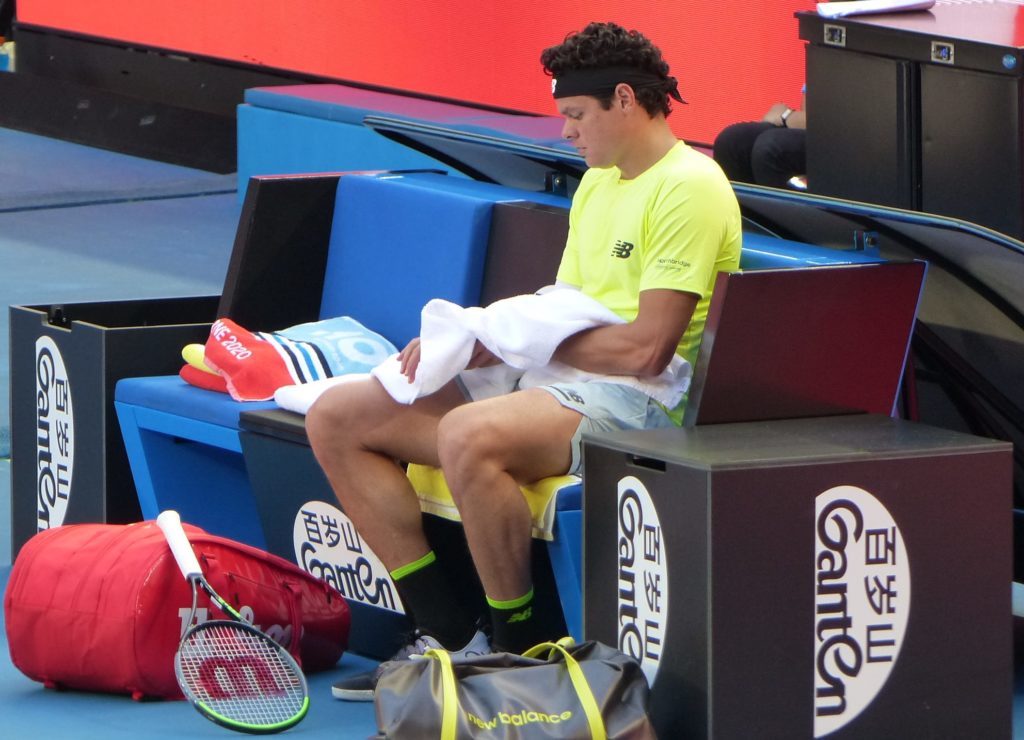
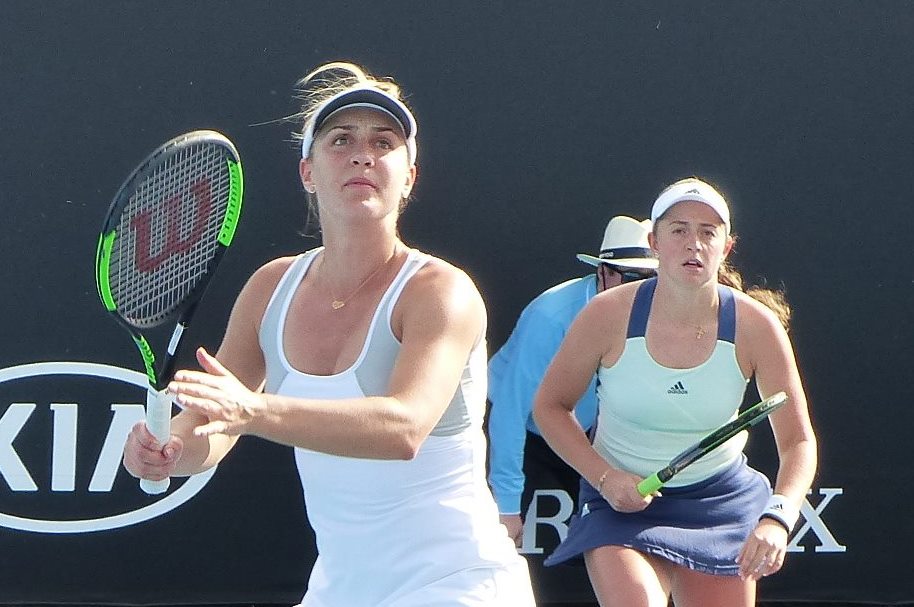 Gabriela Dabrowski and Jelena Ostapenko moved into the second round of the Australian Open doubles on Thursday with a 7-5, 6-3 victory over Maria Sakkari of Greece and Australian Ajla Tomljanovic of Australia.
The sixth-seeded Canadian/Latvian combination broke the Sakkari serve on their third set/break point to wrap up the opening set. It was just the start they needed and they took control in the second set with their superior doubles skills. The win booked them a second-round encounter with Americans Asia Muhammad, 28, and Sabrina Santamaria, 26, on Saturday.
Both Ostapenko (Belinda Bencic) and Tomljanovic (Garbine Muguruza) had lost in singles earlier in the day.
The stats were one-sided for Dabrowski and Ostapenko, the 2017 French Open singles champion. Their break point conversion ratio was 4/13 to 2/7 for Sakkari and Tomljanovic and they had 29 winners to 12 for their opponents in the one hour and 23-minute match on Court 10.
In the mixed doubles on Friday, Dabrowski and Henri Kontinen of Finland, seeded third, defeated Lucie Hradecka of the Czech Republic and Kevin Krawietz of Germany 6-2, 6-4 in a first-round match.
Gabriela Dabrowski and Jelena Ostapenko moved into the second round of the Australian Open doubles on Thursday with a 7-5, 6-3 victory over Maria Sakkari of Greece and Australian Ajla Tomljanovic of Australia.
The sixth-seeded Canadian/Latvian combination broke the Sakkari serve on their third set/break point to wrap up the opening set. It was just the start they needed and they took control in the second set with their superior doubles skills. The win booked them a second-round encounter with Americans Asia Muhammad, 28, and Sabrina Santamaria, 26, on Saturday.
Both Ostapenko (Belinda Bencic) and Tomljanovic (Garbine Muguruza) had lost in singles earlier in the day.
The stats were one-sided for Dabrowski and Ostapenko, the 2017 French Open singles champion. Their break point conversion ratio was 4/13 to 2/7 for Sakkari and Tomljanovic and they had 29 winners to 12 for their opponents in the one hour and 23-minute match on Court 10.
In the mixed doubles on Friday, Dabrowski and Henri Kontinen of Finland, seeded third, defeated Lucie Hradecka of the Czech Republic and Kevin Krawietz of Germany 6-2, 6-4 in a first-round match.
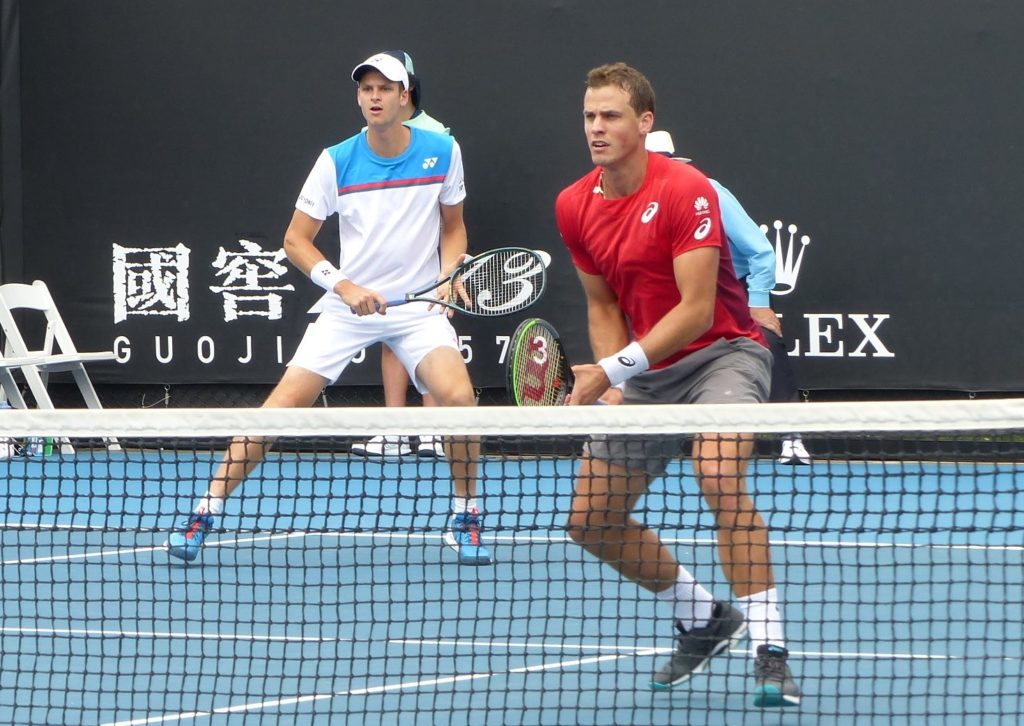 Vasek Pospisil and Hubert Hurkacz of Poland were beaten 6-4, 6-4 in the first round of men’s doubles Friday by Jamie Murray and Neal Skupski.
The 14th-seeded Brits broke the Hurkacz serve to 4-3 in the first set and again in the opening game of the second set. While Murray and Skupski converted on two of seven break point chances, Pospisil and Hurkacz failed to reach break point in any of the British team’s ten services games.
There were three experienced and capable doubles players on the court, with the 22-year-old Hurkacz, who ranks No. 31 in singles, not quite up to speed. He lacked a certain doubles sense and had an obvious inability to put away volleys at the net.
Murray is ranked No. 25 in doubles while Skupski is No. 31. Hurkacz is No. 247 and has only played 16 matches (2-14) in his pro career. Pospisil is currently tied for No. 449 but was off the tour rehabbing a back injury from January to July last year and was just 3-4 for the 2019 season – with only one win counting toward an ATP doubles ranking. That was the first round at Wimbledon with Matthew Ebden of Australia. His career high was No. 4 in 2015 and his career overall doubles record is 102-79.
Neither Pospisil, who lost in the first round of singles to Ivo Karlovic of Croatia, nor Hurkacz, who was beaten in the second round by Aussie John Millman, are entered in the mixed doubles event.
Vasek Pospisil and Hubert Hurkacz of Poland were beaten 6-4, 6-4 in the first round of men’s doubles Friday by Jamie Murray and Neal Skupski.
The 14th-seeded Brits broke the Hurkacz serve to 4-3 in the first set and again in the opening game of the second set. While Murray and Skupski converted on two of seven break point chances, Pospisil and Hurkacz failed to reach break point in any of the British team’s ten services games.
There were three experienced and capable doubles players on the court, with the 22-year-old Hurkacz, who ranks No. 31 in singles, not quite up to speed. He lacked a certain doubles sense and had an obvious inability to put away volleys at the net.
Murray is ranked No. 25 in doubles while Skupski is No. 31. Hurkacz is No. 247 and has only played 16 matches (2-14) in his pro career. Pospisil is currently tied for No. 449 but was off the tour rehabbing a back injury from January to July last year and was just 3-4 for the 2019 season – with only one win counting toward an ATP doubles ranking. That was the first round at Wimbledon with Matthew Ebden of Australia. His career high was No. 4 in 2015 and his career overall doubles record is 102-79.
Neither Pospisil, who lost in the first round of singles to Ivo Karlovic of Croatia, nor Hurkacz, who was beaten in the second round by Aussie John Millman, are entered in the mixed doubles event.
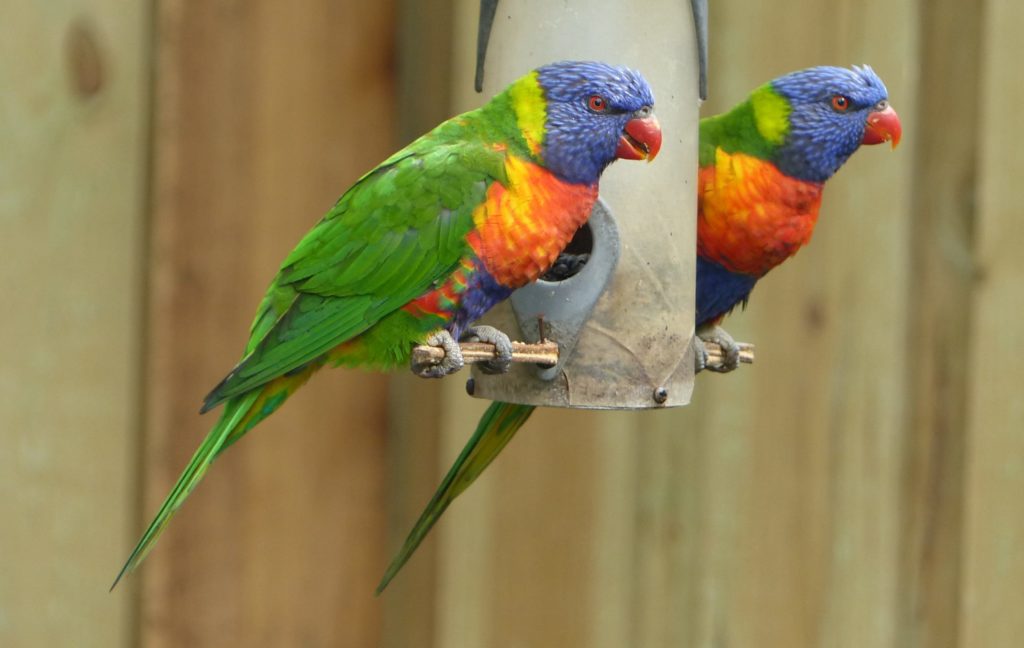 The scaly-breasted lorikeet is indigenous to Australia and can be found in many Melbourne suburbs. It belongs to the parrot family of birds.
The scaly-breasted lorikeet is indigenous to Australia and can be found in many Melbourne suburbs. It belongs to the parrot family of birds.
 The margins weren’t that great but Raonic always seemed to have the upper hand. There were only two service breaks in the match and they came at opportune times for Raonic – one in the penultimate game of the first set and one in the opening game of the second set, setting the tone and allowing him to continue to on build his momentum.
But there was more than the serve for Raonic, who was hyper-aggressive on the night in Margaret Court Arena, never giving Tsitsipas a chance to get comfortable with his game. “He’s playing forehands from all over the court and you really don’t know where you should stand exactly because he’s so fast turning around and hitting those forehands,” Tsitsipas said.
The forehand was dynamite but Raonic was also almost impeccable volleying and hitting his overheads. He had 55 winners compared to 23 for Tsitsipas and was timely with his incursions to the net – winning 29 of 41 net points.
“I knew for me today it was going to be important that I play well,” Raonic said, “and I played consistently well throughout the match. I wasn’t having any fluctuations. I think that was how I was going to create my opportunities, and it worked out well.”
He had six chances to break serve and broke twice – Tsitsipas had no chances and said the last time he played a best-of-five set match and didn’t have a break point was in 2017 against John Isner at Wimbledon.
The all-round mastery Raonic displayed on the night was never more evident than in the decisive third-set tiebreak. Leading 2-1, he moved forward and put away a backhand volley to get the mini-break, and a lead he would not relinquish – stretching it to 6-1 and eventually closing out 7-2.
The margins weren’t that great but Raonic always seemed to have the upper hand. There were only two service breaks in the match and they came at opportune times for Raonic – one in the penultimate game of the first set and one in the opening game of the second set, setting the tone and allowing him to continue to on build his momentum.
But there was more than the serve for Raonic, who was hyper-aggressive on the night in Margaret Court Arena, never giving Tsitsipas a chance to get comfortable with his game. “He’s playing forehands from all over the court and you really don’t know where you should stand exactly because he’s so fast turning around and hitting those forehands,” Tsitsipas said.
The forehand was dynamite but Raonic was also almost impeccable volleying and hitting his overheads. He had 55 winners compared to 23 for Tsitsipas and was timely with his incursions to the net – winning 29 of 41 net points.
“I knew for me today it was going to be important that I play well,” Raonic said, “and I played consistently well throughout the match. I wasn’t having any fluctuations. I think that was how I was going to create my opportunities, and it worked out well.”
He had six chances to break serve and broke twice – Tsitsipas had no chances and said the last time he played a best-of-five set match and didn’t have a break point was in 2017 against John Isner at Wimbledon.
The all-round mastery Raonic displayed on the night was never more evident than in the decisive third-set tiebreak. Leading 2-1, he moved forward and put away a backhand volley to get the mini-break, and a lead he would not relinquish – stretching it to 6-1 and eventually closing out 7-2.
 Tsitsipas was remarkably candid after the match, saying about facing such an exceptional server, “you have such a great server like (6-foot-5) him and you’re trying to, because you’re tall (6-foot-4) as well, you’re trying to do the same as him. Then you cannot be like him – he’s him, you’re you.”
Tsitsipas, being “you’re you,” had nine aces to 19 for Raonic.
The 21-year-old Greek seemed edgy the first two sets trying to find an answer for Raonic’s powerful serving and aggressive ground game. But in the third he knuckled down and played nearer his best level but still Raonic was just that little bit better.
“In the tiebreak, he was very, very aggressive,” Tsitsipas said. “I was passive, I wasn’t pressing. Yeah, he was doing a lot of damage with his forehand.”
Tsitsipas was remarkably candid after the match, saying about facing such an exceptional server, “you have such a great server like (6-foot-5) him and you’re trying to, because you’re tall (6-foot-4) as well, you’re trying to do the same as him. Then you cannot be like him – he’s him, you’re you.”
Tsitsipas, being “you’re you,” had nine aces to 19 for Raonic.
The 21-year-old Greek seemed edgy the first two sets trying to find an answer for Raonic’s powerful serving and aggressive ground game. But in the third he knuckled down and played nearer his best level but still Raonic was just that little bit better.
“In the tiebreak, he was very, very aggressive,” Tsitsipas said. “I was passive, I wasn’t pressing. Yeah, he was doing a lot of damage with his forehand.”
 Really the only time Tsitsipas appeared to be getting a handle on the Raonic serve was when he saved three set points from love-40 in the final game of the second set. He saved a fourth too but not a fifth as Raonic tied a bow on the set with a 189 km/hr ace followed by a 212 km/hr service winner.
The 7,500-seat Margaret Court Arena is a sweet place to play a match, especially on a pleasant, temperate summer night and Raonic expressed his appreciation to the crowd in the post-match, on-court interview. “Obviously today was an incredible match for me and I’m very happy with how things went,” he said. “To be back here in Margaret Court – it’s been a while and I always enjoy it here. It’s fun to be healthy and to be playing well. I really take a lot of pleasure in that.”
Raonic attributes his fine form to time he spent in November and December rehabbing a troublesome back that plagued most of last year. “I switched around the people that are with me,” he said, “so the methods have been a little bit different in that sense. So tennis coaches (Mario Tudor, a 41-year-old Croat) stayed the same. Everybody else sort of rotated around what I was doing in the gym, how I was rehabbing and these kinds of things. I spent two weeks in Boston to help focus on a few things there with a group of guys, and then I spent four weeks training down in the Caribbean (the Bahamas).”
With his three wins at the 2020 Australian Open, the event has officially become his most successful Grand Slam tournament. His match record is 30-9 at Melbourne Park and Wimbledon is now No. 2 at 27-9.
“I’m just mentally fresh because I haven’t carried a lot of things with me like I might through other parts of the year,” Raonic explained about his good results at the AO, including a semi-final in 2016, ‘like the US Open where I think I should have done better, considering how those courts play. I think it’s more my situation that I bring into the tournament than anything else.
“And I think here it tends to be warmer, speeds it up a little bit. It can be humid but most of the time it’s not too humid, so that also allows the ball to move quicker through the court.”
Really the only time Tsitsipas appeared to be getting a handle on the Raonic serve was when he saved three set points from love-40 in the final game of the second set. He saved a fourth too but not a fifth as Raonic tied a bow on the set with a 189 km/hr ace followed by a 212 km/hr service winner.
The 7,500-seat Margaret Court Arena is a sweet place to play a match, especially on a pleasant, temperate summer night and Raonic expressed his appreciation to the crowd in the post-match, on-court interview. “Obviously today was an incredible match for me and I’m very happy with how things went,” he said. “To be back here in Margaret Court – it’s been a while and I always enjoy it here. It’s fun to be healthy and to be playing well. I really take a lot of pleasure in that.”
Raonic attributes his fine form to time he spent in November and December rehabbing a troublesome back that plagued most of last year. “I switched around the people that are with me,” he said, “so the methods have been a little bit different in that sense. So tennis coaches (Mario Tudor, a 41-year-old Croat) stayed the same. Everybody else sort of rotated around what I was doing in the gym, how I was rehabbing and these kinds of things. I spent two weeks in Boston to help focus on a few things there with a group of guys, and then I spent four weeks training down in the Caribbean (the Bahamas).”
With his three wins at the 2020 Australian Open, the event has officially become his most successful Grand Slam tournament. His match record is 30-9 at Melbourne Park and Wimbledon is now No. 2 at 27-9.
“I’m just mentally fresh because I haven’t carried a lot of things with me like I might through other parts of the year,” Raonic explained about his good results at the AO, including a semi-final in 2016, ‘like the US Open where I think I should have done better, considering how those courts play. I think it’s more my situation that I bring into the tournament than anything else.
“And I think here it tends to be warmer, speeds it up a little bit. It can be humid but most of the time it’s not too humid, so that also allows the ball to move quicker through the court.”
 Before the Raonic – Tsitsipas contest, veteran umpire Mohamed Lahyani of Sweden engaged in a little stretching to prepare for what would wind up being a two-and-a-half hour match.
Next for Raonic will be Marin Cilic, the 31-year-old Croat who, like No. 35 Raonic, has slipped in the rankings to No. 39 from a high of No. 3 exactly two years ago. The two have played three times and Cilic holds a 2-1 advantage. But the matches go back to the now-defunct indoor event in Valencia, Spain, (Cilic in 2011), Indian Wells (Raonic in 2013) and the Istanbul final on clay (Cilic in 2017).
On Friday Cilic defeated form player and No. 9 seed Roberto Bautista Agut 6-7(3). 6-4, 6-0, 5-7, 6-3. That followed on the heels of another five-setter – 6-2, 6-7(6), 3-6, 6-1, 7-6(3) over No. 21 seed Benoit Paire in the second round.
“Marin, it’s going to be tough,” Raonic said. “He’s won two very good matches – the last two and even the first one he won comfortably against a guy (Corentin Moutet of France) who played finals (Doha) and who I lost to in the first tournament of the year (Doha).
“So I’m going to have to focus on my things. I think we’re both going to be trying to move the other guy around, be the one dictating. It’s going to be important for me to get ahead early in the points, take care of my serve, and be the aggressor.”
It was the formula for success against Tsitsipas – but then again when hasn’t it been a winning formula for Raonic?
Before the Raonic – Tsitsipas contest, veteran umpire Mohamed Lahyani of Sweden engaged in a little stretching to prepare for what would wind up being a two-and-a-half hour match.
Next for Raonic will be Marin Cilic, the 31-year-old Croat who, like No. 35 Raonic, has slipped in the rankings to No. 39 from a high of No. 3 exactly two years ago. The two have played three times and Cilic holds a 2-1 advantage. But the matches go back to the now-defunct indoor event in Valencia, Spain, (Cilic in 2011), Indian Wells (Raonic in 2013) and the Istanbul final on clay (Cilic in 2017).
On Friday Cilic defeated form player and No. 9 seed Roberto Bautista Agut 6-7(3). 6-4, 6-0, 5-7, 6-3. That followed on the heels of another five-setter – 6-2, 6-7(6), 3-6, 6-1, 7-6(3) over No. 21 seed Benoit Paire in the second round.
“Marin, it’s going to be tough,” Raonic said. “He’s won two very good matches – the last two and even the first one he won comfortably against a guy (Corentin Moutet of France) who played finals (Doha) and who I lost to in the first tournament of the year (Doha).
“So I’m going to have to focus on my things. I think we’re both going to be trying to move the other guy around, be the one dictating. It’s going to be important for me to get ahead early in the points, take care of my serve, and be the aggressor.”
It was the formula for success against Tsitsipas – but then again when hasn’t it been a winning formula for Raonic?

DABROWSKI / OSTAPENKO INTO ROUND 2
 Gabriela Dabrowski and Jelena Ostapenko moved into the second round of the Australian Open doubles on Thursday with a 7-5, 6-3 victory over Maria Sakkari of Greece and Australian Ajla Tomljanovic of Australia.
The sixth-seeded Canadian/Latvian combination broke the Sakkari serve on their third set/break point to wrap up the opening set. It was just the start they needed and they took control in the second set with their superior doubles skills. The win booked them a second-round encounter with Americans Asia Muhammad, 28, and Sabrina Santamaria, 26, on Saturday.
Both Ostapenko (Belinda Bencic) and Tomljanovic (Garbine Muguruza) had lost in singles earlier in the day.
The stats were one-sided for Dabrowski and Ostapenko, the 2017 French Open singles champion. Their break point conversion ratio was 4/13 to 2/7 for Sakkari and Tomljanovic and they had 29 winners to 12 for their opponents in the one hour and 23-minute match on Court 10.
In the mixed doubles on Friday, Dabrowski and Henri Kontinen of Finland, seeded third, defeated Lucie Hradecka of the Czech Republic and Kevin Krawietz of Germany 6-2, 6-4 in a first-round match.
Gabriela Dabrowski and Jelena Ostapenko moved into the second round of the Australian Open doubles on Thursday with a 7-5, 6-3 victory over Maria Sakkari of Greece and Australian Ajla Tomljanovic of Australia.
The sixth-seeded Canadian/Latvian combination broke the Sakkari serve on their third set/break point to wrap up the opening set. It was just the start they needed and they took control in the second set with their superior doubles skills. The win booked them a second-round encounter with Americans Asia Muhammad, 28, and Sabrina Santamaria, 26, on Saturday.
Both Ostapenko (Belinda Bencic) and Tomljanovic (Garbine Muguruza) had lost in singles earlier in the day.
The stats were one-sided for Dabrowski and Ostapenko, the 2017 French Open singles champion. Their break point conversion ratio was 4/13 to 2/7 for Sakkari and Tomljanovic and they had 29 winners to 12 for their opponents in the one hour and 23-minute match on Court 10.
In the mixed doubles on Friday, Dabrowski and Henri Kontinen of Finland, seeded third, defeated Lucie Hradecka of the Czech Republic and Kevin Krawietz of Germany 6-2, 6-4 in a first-round match.
POSPISIL / HURKACZ OUT TO BRITS
 Vasek Pospisil and Hubert Hurkacz of Poland were beaten 6-4, 6-4 in the first round of men’s doubles Friday by Jamie Murray and Neal Skupski.
The 14th-seeded Brits broke the Hurkacz serve to 4-3 in the first set and again in the opening game of the second set. While Murray and Skupski converted on two of seven break point chances, Pospisil and Hurkacz failed to reach break point in any of the British team’s ten services games.
There were three experienced and capable doubles players on the court, with the 22-year-old Hurkacz, who ranks No. 31 in singles, not quite up to speed. He lacked a certain doubles sense and had an obvious inability to put away volleys at the net.
Murray is ranked No. 25 in doubles while Skupski is No. 31. Hurkacz is No. 247 and has only played 16 matches (2-14) in his pro career. Pospisil is currently tied for No. 449 but was off the tour rehabbing a back injury from January to July last year and was just 3-4 for the 2019 season – with only one win counting toward an ATP doubles ranking. That was the first round at Wimbledon with Matthew Ebden of Australia. His career high was No. 4 in 2015 and his career overall doubles record is 102-79.
Neither Pospisil, who lost in the first round of singles to Ivo Karlovic of Croatia, nor Hurkacz, who was beaten in the second round by Aussie John Millman, are entered in the mixed doubles event.
Vasek Pospisil and Hubert Hurkacz of Poland were beaten 6-4, 6-4 in the first round of men’s doubles Friday by Jamie Murray and Neal Skupski.
The 14th-seeded Brits broke the Hurkacz serve to 4-3 in the first set and again in the opening game of the second set. While Murray and Skupski converted on two of seven break point chances, Pospisil and Hurkacz failed to reach break point in any of the British team’s ten services games.
There were three experienced and capable doubles players on the court, with the 22-year-old Hurkacz, who ranks No. 31 in singles, not quite up to speed. He lacked a certain doubles sense and had an obvious inability to put away volleys at the net.
Murray is ranked No. 25 in doubles while Skupski is No. 31. Hurkacz is No. 247 and has only played 16 matches (2-14) in his pro career. Pospisil is currently tied for No. 449 but was off the tour rehabbing a back injury from January to July last year and was just 3-4 for the 2019 season – with only one win counting toward an ATP doubles ranking. That was the first round at Wimbledon with Matthew Ebden of Australia. His career high was No. 4 in 2015 and his career overall doubles record is 102-79.
Neither Pospisil, who lost in the first round of singles to Ivo Karlovic of Croatia, nor Hurkacz, who was beaten in the second round by Aussie John Millman, are entered in the mixed doubles event.
AUSSIE POST CARD
 The scaly-breasted lorikeet is indigenous to Australia and can be found in many Melbourne suburbs. It belongs to the parrot family of birds.
The scaly-breasted lorikeet is indigenous to Australia and can be found in many Melbourne suburbs. It belongs to the parrot family of birds.



